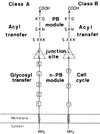Lack of cell wall peptidoglycan versus penicillin sensitivity: new insights into the chlamydial anomaly
- PMID: 10508003
- PMCID: PMC89479
- DOI: 10.1128/AAC.43.10.2339
Lack of cell wall peptidoglycan versus penicillin sensitivity: new insights into the chlamydial anomaly
Figures



Similar articles
-
The alternative to penicillins.Nat Med. 2001 Oct;7(10):1100-1. doi: 10.1038/nm1001-1100. Nat Med. 2001. PMID: 11590425 No abstract available.
-
Penicillin-binding proteins and peptidoglycan peptide-interacting proteins.Microbiol Sci. 1984 Dec;1(9):211-4. Microbiol Sci. 1984. PMID: 6444131 Review.
-
Formation of hyper-crosslinked peptidoglycan with multiple crosslinkages by a penicillin-binding protein, 1A, of Escherichia coli.Biochem Biophys Res Commun. 1982 Jun 30;106(4):1175-82. doi: 10.1016/0006-291x(82)91236-0. Biochem Biophys Res Commun. 1982. PMID: 7052086 No abstract available.
-
Dual enzyme activities of cell wall peptidoglycan synthesis, peptidoglycan transglycosylase and penicillin-sensitive transpeptidase, in purified preparations of Escherichia coli penicillin-binding protein 1A.Biochem Biophys Res Commun. 1980 Nov 17;97(1):287-93. doi: 10.1016/s0006-291x(80)80166-5. Biochem Biophys Res Commun. 1980. PMID: 7006606 No abstract available.
-
Mode of action of beta-lactam antibiotics.Pharmacol Ther. 1985;27(1):1-35. doi: 10.1016/0163-7258(85)90062-2. Pharmacol Ther. 1985. PMID: 3889939 Review. No abstract available.
Cited by
-
Genome sequencing and our understanding of chlamydiae.Infect Immun. 2000 Oct;68(10):5473-9. doi: 10.1128/IAI.68.10.5473-5479.2000. Infect Immun. 2000. PMID: 10992442 Free PMC article. Review. No abstract available.
-
BLAST screening of chlamydial genomes to identify signature proteins that are unique for the Chlamydiales, Chlamydiaceae, Chlamydophila and Chlamydia groups of species.BMC Genomics. 2006 Jan 25;7:14. doi: 10.1186/1471-2164-7-14. BMC Genomics. 2006. PMID: 16436211 Free PMC article.
-
Diagnosis and assessment of trachoma.Clin Microbiol Rev. 2004 Oct;17(4):982-1011, table of contents. doi: 10.1128/CMR.17.4.982-1011.2004. Clin Microbiol Rev. 2004. PMID: 15489358 Free PMC article. Review.
-
Spectroscopic analysis of chlamydial major outer membrane protein in support of structure elucidation.Protein Sci. 2018 Nov;27(11):1923-1941. doi: 10.1002/pro.3501. Protein Sci. 2018. PMID: 30144190 Free PMC article.
-
L,L-diaminopimelate aminotransferase (DapL): a putative target for the development of narrow-spectrum antibacterial compounds.Front Microbiol. 2014 Sep 26;5:509. doi: 10.3389/fmicb.2014.00509. eCollection 2014. Front Microbiol. 2014. PMID: 25309529 Free PMC article.
References
-
- Adam M, Fraipont C, Rhazi N, Nguyen-Distèche M, Lakaye B, Frère J-M, Devreese B, Van Beeumen J, van Heijenoort Y, van Heijenoort J, Ghuysen J-M. The bimodular G57-V577 polypeptide chain of the class B penicillin-binding protein 3 of Escherichia coli catalyzes peptide bond formation from thiolesters and does not catalyze glycan chain polymerization from the lipid II intermediate. J Bacteriol. 1997;179:6005–6009. - PMC - PubMed
-
- Armstrong D W, Gasper M, Lee S H, Zukowski J, Ercal N. d-Amino acid levels in human physiological fluids. Chirality. 1993;5:375–378. - PubMed
-
- Boyle D S, Khattar M M, Addinall S G, Lutkenhaus J, Donachie W D. FtsW is an essential cell-division gene in Escherichia coli. Mol Microbiol. 1997;24:1263–1273. - PubMed
Publication types
MeSH terms
Substances
LinkOut - more resources
Full Text Sources

